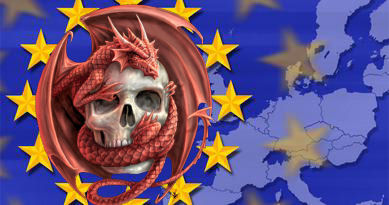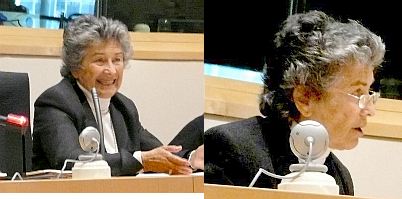
After Paul Weston published his
brief account of our role in the Counterjihad Brussels 2007 conference, several people have asked me to write a history of the Counterjihad movement.
As it happens, such a history was already in preparation at the time Paul wrote his testimonial, and had been for several months. It was written by the Counterjihad Collective, a group of people (including myself) who have firsthand knowledge of the history of the transatlantic Counterjihad.
The paper has just been completed, but it’s too long for one blog post. I’ll post it here in eight parts, broken up into its numbered topics, which are of varying lengths.
Many thanks to all the people who contributed to this project.
 A Brief History of the Transatlantic Counterjihad
A Brief History of the Transatlantic Counterjihad
by the Counterjihad CollectiveI. IntroductionOver the past few years a transatlantic political and social movement that is now commonly known as the Counterjihad has gained increasing prominence. As it became more mainstream, it attracted attention from the legacy media, especially in Europe, where the debate over Islamization has made it to the pages of major newspapers.
The resistance to Islamization and sharia started long before September 11, 2001. The roots of the movement can be traced back to antiquity, since the first violent
razzia against Christian civilization in the 7th century, under Mohammed and the early Caliphs. Successive
jihad attacks destroyed the Christian cultures of the Middle East, North Africa, and parts of southern Europe. With each wave of Islamic invasion, Europeans became aware of Islamic ideology through its deadly praxis. Popes, Patriarchs, and scholars wrote about the nature of the Mohammedan aggression, and the necessity for resistance to it. European Christians massed forces to launch Crusades in an attempt to reclaim Muslim-conquered territories in the Near East for Christendom.
Moorish Islam was expelled from Spain by the Reconquista in 1492, and the tide of the Ottoman expansion was turned back at the Gates of Vienna in 1683. For the next two centuries European civilization was ascendant, as Turkish power gradually receded and disappeared from the Balkans and Greece. Europeans were technologically superior to Islamic cultures, and became the colonial masters of Muslims in North Africa, Asia Minor, the Arabian Peninsula, the Indian subcontinent, and the archipelagoes of the Indian Ocean.
During those years the ideology of Islam ceased to matter to Europeans, and the violent and expansionist doctrines of the Koran, the hadith, and the Sunna no longer drew much attention among non-Muslims. Occasionally a European writer — most notably Winston Churchill, in
The River War — would analyze the barbaric, inhumane, and imperialistic ideology of the Mohammedans. By and large, however, the menace of Islamic violence, which had been intimately familiar to millions of Europeans for a millennium, was forgotten.
All that changed when the ownership of Middle Eastern oil fields passed from European and American corporations into the hands of Muslim emirs. Suddenly the Islamic world was awash with wealth. And, for the first time in history, all that bounty became available to Muslims without the necessity of conquest and slaughter.
The reality of Islamic economic power drew the attention of the West during the oil crisis of 1974. The satraps of Muslim countries were able to put a thumb on the petroleum carotid of Western Europe and bring European political leaders to their knees. In the ensuing years, the Islamic colonization of London, Paris, Marseille, Brussels, and Rotterdam began in Europe. The first urban Islamic enclaves formed in those cities and others, becoming the nuclei of the notorious no-go zones and sharia enclaves that have metastasized for the last three decades all across Western Europe.
Among Sunni Muslims the fundamentalist revival was spearheaded by a group known as
Al-Ikhwan Al-Muslimeen, or the Muslim Brotherhood. Founded in Egypt in 1928 by Hassan al-Banna, the Brotherhood grew in popularity during the middle of the 20th century, even under official state repression by the Nasser regime. Al-Banna was assassinated in 1949, after which Sayyid Qutb took over the leadership of the group. Qutb was a prolific writer and theoretician, and his works inspired millions of Sunni Muslims throughout the Middle East and beyond. By the time he was hanged in 1966, the Muslim Brotherhood had become a formidable force in Middle Eastern politics, even though it was banned. The stage was thus set for the oil-funded Islamic revival.
The current crisis began with the Islamic Revolution in Iran in 1979. The origins of the Counterjihad may be traced to the writer V.S. Naipaul, who was the first prominent observer to understand what was at stake, and what lay ahead. He visited Iran and other Muslim countries in the wake of the Iranian revolution in an attempt to understand the Islamic awakening. The following report, from the hinterlands of Sind in Pakistan, presents the Islamic worldview in a nutshell*:
 In the wake of yesterday’s attack by “students” on the British embassy in Iran, the British government has ordered the closure of the Iranian embassy in London. It has also given Iranian diplomats 48 hours to leave the UK.
In the wake of yesterday’s attack by “students” on the British embassy in Iran, the British government has ordered the closure of the Iranian embassy in London. It has also given Iranian diplomats 48 hours to leave the UK.




 When an important article, essay, or speech is published, a move is initiated among the various Counterjihad groups to have it translated into as many languages as possible. The influence of the text can be greatly extended if it is spread in multiple languages, and gives the author a much wider audience.
When an important article, essay, or speech is published, a move is initiated among the various Counterjihad groups to have it translated into as many languages as possible. The influence of the text can be greatly extended if it is spread in multiple languages, and gives the author a much wider audience.

 Have we not seen this in the last few weeks? Frau Merkel and Monsieur Sarkozy are both on record stating their intention to wrest further EU control from the European electorate in the wake of the Eurozone economic catastrophe (inflicted by EU economic policy) and they are now doing this in spades.
Have we not seen this in the last few weeks? Frau Merkel and Monsieur Sarkozy are both on record stating their intention to wrest further EU control from the European electorate in the wake of the Eurozone economic catastrophe (inflicted by EU economic policy) and they are now doing this in spades.








